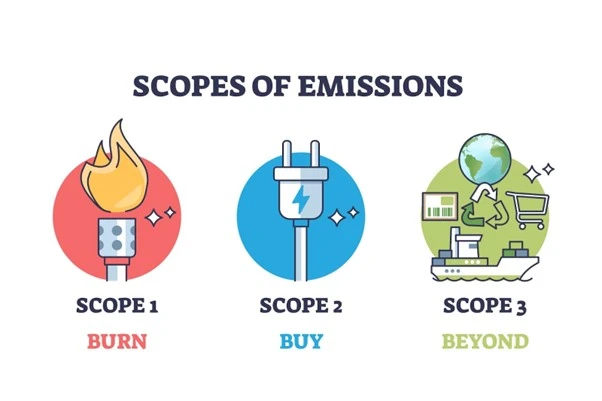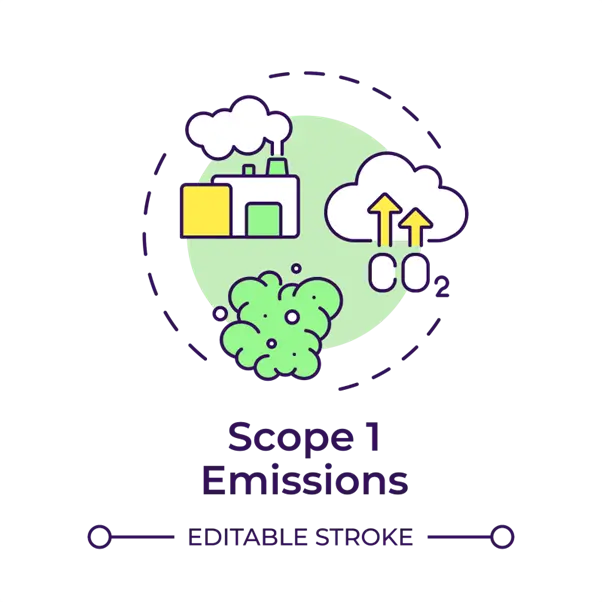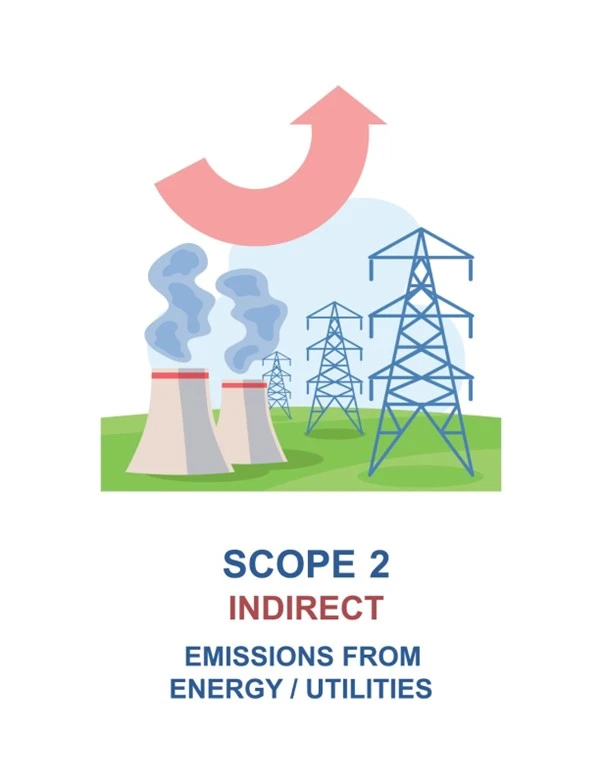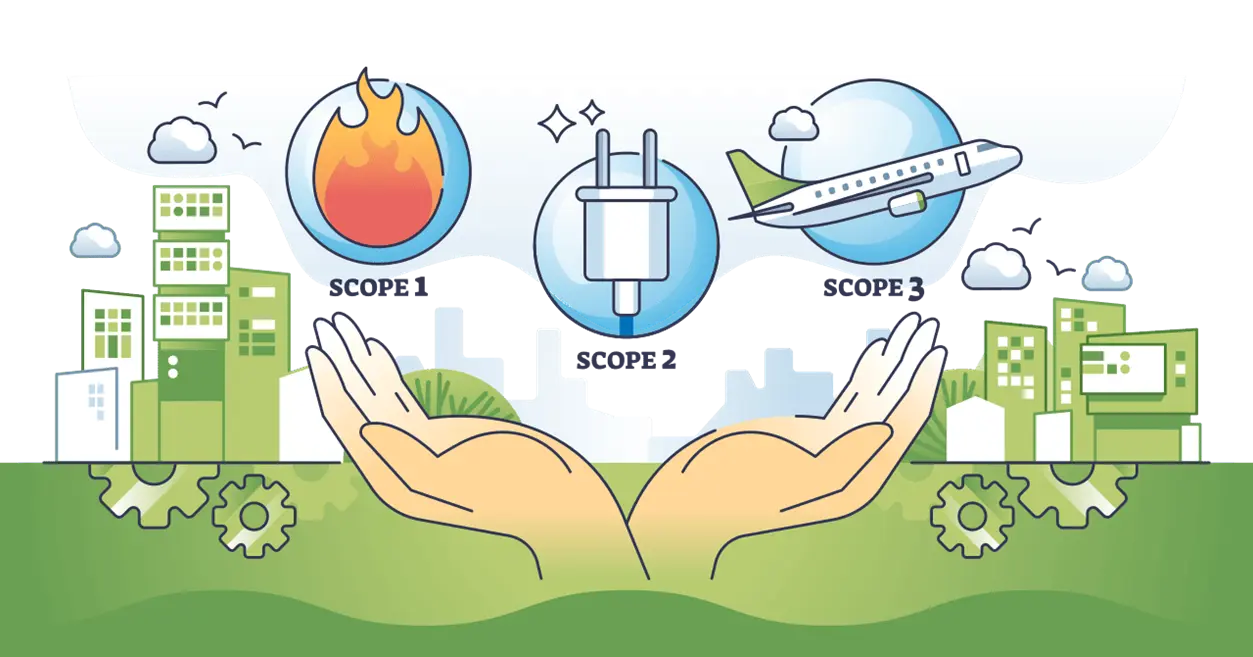
Awareness about climate change is burgeoning across many countries, including India. Humankind understands that climate change poses a significant threat to life on Earth. Meanwhile, businesses play a particularly significant role in climate change.

How do entities contribute to climate change?
Diverse industrial sectors produce enormous carbon emissions. Day by day, these carbon emissions join the atmosphere, and the carbon footprint is increasing. This contributes significantly to climate change.
Therefore, measuring and understanding Scope 1, Scope 2, and Scope 3 emissions are necessary for businesses to achieve net zero
What is Scope 1, Scope 2, Scope 3, and Scope 4 carbon emission?
Scope 1: Direct GHG Emission
Scope 1 emissions refer to direct greenhouse gas (GHG) emissions that occur from sources owned or controlled by an organization within the boundaries of the organization.

For instance:
- Emissions from the combustion of fossil fuels in on-site boilers or generators.
- Emissions from company-owned vehicles.
- Fugitive emissions from industrial processes.
Scope 1 examples:
- Stationary combustion: This implies emissions resulting from burning fuels in stationary apparatus such as turbines, boilers, or generators. These carbon emissions are typically found in:
- Power plants
- Industrial facilities
- Commercial buildings
- Mobile combustion: This type of greenhouse gas emission emanates from burning fuel in all vehicles that are controlled by firms. For example: organization buses, trucks, and cars.
- Process emissions: Within a site, greenhouse gas emissions are released during manufacturing and chemical processing.
- Fugitive emissions: Fugitive emissions are either irregular greenhouse gas releases or gas leaks from industrial activities and processes. Fugitive emissions are not willfully emitted. They come from various sources of leaks and irregular releases.
Carbon emissions of Scope 2

Before entering the discussion on Scope 2 emissions:
Are you struggling to measure your carbon emissions? Would you like to develop an industry-specific strategy to reduce your carbon emissions? Do you want a clear picture of your carbon footprint?
Scope 2 carbon emissions represent indirect emissions, which means they come from the generation of purchased electricity, heat, or steam consumed by the organization. These greenhouse gas emissions do not originate directly from the organization's operations but are associated with the activities that supply the energy the organization uses.
- Location-based target: Location-based emission targets are calculated based on the grid mix where the electricity is used.
- Market-based target: Market-based emission targets are calculated based on the emissions associated with the electricity purchased, regardless of the grid mix.
Carbon emissions of Scope 3

In simple terms, Scope 3 emissions are produced throughout an organization's activities, such as its transportation and supply chain.
Compared to Scope 1 and Scope 2 emissions, Scope 3 emissions can be more challenging to calculate accurately. If an organization has not measured Scope 3 emissions properly, it will be more complex to create enhanced ESG reports.
According to the GHG Protocol, Scope 3 emissions are separated into fifteen categories. Each category has a different calculation method, and the organization should decide which calculation method is appropriate for its business based on its operations.
Furthermore, categories are divided into upstream and downstream:
- Upstream: This implies emissions are generated by activities in the organization's value chain before the organization receives the product or service.
Category 1: Business travel:
This category includes emissions emanating from employee business travel, which includes travel by bus, train, and air.
Category 2: Employee commuting:
This category includes emissions due to employee travel to and from the office using various modes of transportation.
Category 3: Capital goods:
This category includes emissions associated with the purchase of capital goods.
Category 4: Transportation and distribution:
This category includes emissions generated during the transportation and distribution of materials to suppliers and customers.
Category 5: Waste generation:
This category includes emissions generated from waste produced during business operations.
Category 6: Fuel and energy-related activities:
These emissions do not fall under Scope 1 or Scope 2. They originate from the activities of processing, production, and transportation of fuels and energy.
Category 7: Fuel and energy-related activities:
These emissions also do not fall under Scope 1 or Scope 2.
Category 8: Purchased goods and services:
This category varies significantly based on the industry.
For instance:
If an organization is in the construction industry, 10 to 12% of emissions may come from purchased goods and services.
Downstream represents emissions generated after goods and services have departed from the organization. It encompasses various aspects such as:
- Processing of sold products
- Processing of sold products
- End-of-life treatment of sold products
- Downstream transportation and distribution
- Franchises
- Investments
What is meant by Scope 4 emission?
Scope 4 emissions are not officially recognized under the GHG Protocol. However, the concept often refers to reducing emissions by encouraging consumers to use products more environmentally friendly.
What is meant by the GHG Protocol?
The GHG Protocol is a framework used by private organizations, businesses, and governments to measure their greenhouse gas emissions. It provides precise guidelines on how to calculate Scope 1, Scope 2, and Scope 3 emissions.
Ways to reduce scope emissions, which include Scope 4
For Scope 1:
- Optimize machinery: Many industrial machines rely on fossil fuels. Replacing older, less efficient machinery with more energy-efficient models can significantly reduce emissions consumption.
- Use digital technology: Many tools are available in the market, especially advanced carbon accounting tools, that can effectively help you measure your scope emissions accurately and provide industry-specific solutions to reduce them.
Ways to reduce scope emissions, which include Scope 4
For Scope 2:
- Use Renewable Energy: One of the most impactful ways to reduce Scope 2 emissions is to invest in renewable energy sources. Running business operations using renewable energy is environmentally friendly and can also reduce operational costs.
- Invest in green energy: Due to organizational size or location constraints, installing renewable energy on-site may not always be feasible. Investing in Power Purchase Agreements (PPAs) is a great way to procure renewable energy from off-site sources and reduce Scope 2 emissions.
For Scope 3:
- Optimize transportation: Utilize carbon-free vehicles and ensure suppliers adopt sustainable practices in their operations.
For Scope 4:
- Promote the use of more environmentally friendly products.
- Switch to renewable energy sources for personal use.
- Engage with suppliers and partners to encourage their own sustainability efforts.
Why is measuring scope emissions important?
Measuring scope emissions offers numerous benefits to organizations. Cost savings and improved brand reputation are significant benefits of measuring scope emissions. Apart from that:
- It has become a necessity for many organizations.
- It allows for the easy identification of emission hotspots across business operations.
- It helps to attract potential investors who are increasingly interested in companies with strong sustainability performance.
To Sum up:
Understanding and mitigating climate change are critical for the future of our planet. Businesses play a vital role in this effort.
By accurately measuring and reducing their Scope 1, 2, and 3 emissions, organizations can contribute to a more sustainable future.
Implementing strategies such as energy efficiency, renewable energy adoption, and supply chain decarbonization is crucial for achieving net-zero goals and mitigating the impacts of climate change.

